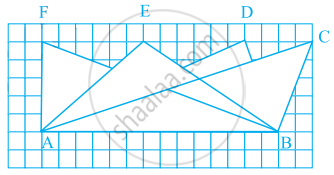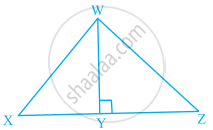Advertisements
Advertisements
प्रश्न
Find the area of ΔABC with A(1, -4) and midpoints of sides through A being (2, -1) and (0, -1).
उत्तर
Let ( x2, y2) and (x3, y3) be the coordinates of B and C respectively. Since, the coordinates of A are (1,-4) , therefore
`(1+x_2)/2= 2⇒x_2 = 3`
`(-4+y_2)/2=-1⇒y_2 = 2`
`(1+x_2)/2 =0⇒x_3=-1`
`(-4+y_3)/2 = -1 ⇒ y_3 = 2`
` " let " A (x_1,y_1) = A (1,-4) , B (x_2,y_2) = B(3,2) and C(x_3,y_3) = C (-1,2) Now`
`"Area " (Δ ABC) = 1/2 [x_1(y_2-y_3) +x_2 (y_3-y_1)+x_3(y_1-y
_2)]`
`=1/2 [1(2-2)+(2+4)-1(-4-2)]`
`=1/2[0+18+6]`
=12 sq. units
Hence, the area of the triangle ΔABCis 12 sq. units
APPEARS IN
संबंधित प्रश्न
Find the area of a triangle with vertices at the point given in the following:
(2, 7), (1, 1), (10, 8)
Four points A (6, 3), B (−3, 5), C(4, −2) and D (x, 3x) are given in such a way that `(ΔDBG) /(ΔABG)=1/2,` find x
Find the value of x for which points A(x, 2), B(-3, -4) and C(7, -5) are collinear.
Using integration, find the area of triangle ABC, whose vertices are A(2, 5), B(4, 7) and C(6, 2).
The area of a triangle with vertices (a, b + c), (b, c + a) and (c, a + b) is ______.
If the points A(1, 2), O(0, 0) and C(a, b) are collinear, then ______.
If `D((-1)/2, 5/2), E(7, 3)` and `F(7/2, 7/2)` are the midpoints of sides of ∆ABC, find the area of the ∆ABC.
The base and the corresponding altitude of a parallelogram are 10 cm and 3.5 cm, respectively. The area of the parallelogram is 30 cm2.
Observe all the four triangles FAB, EAB, DAB and CAB as shown in the given figure.

- All triangles have the same base and the same altitude.
- All triangles are congruent.
- All triangles are equal in area.
- All triangles may not have the same perimeter.
Ratio of the area of ∆WXY to the area of ∆WZY is 3:4 in the given figure. If the area of ∆WXZ is 56 cm2 and WY = 8 cm, find the lengths of XY and YZ.

